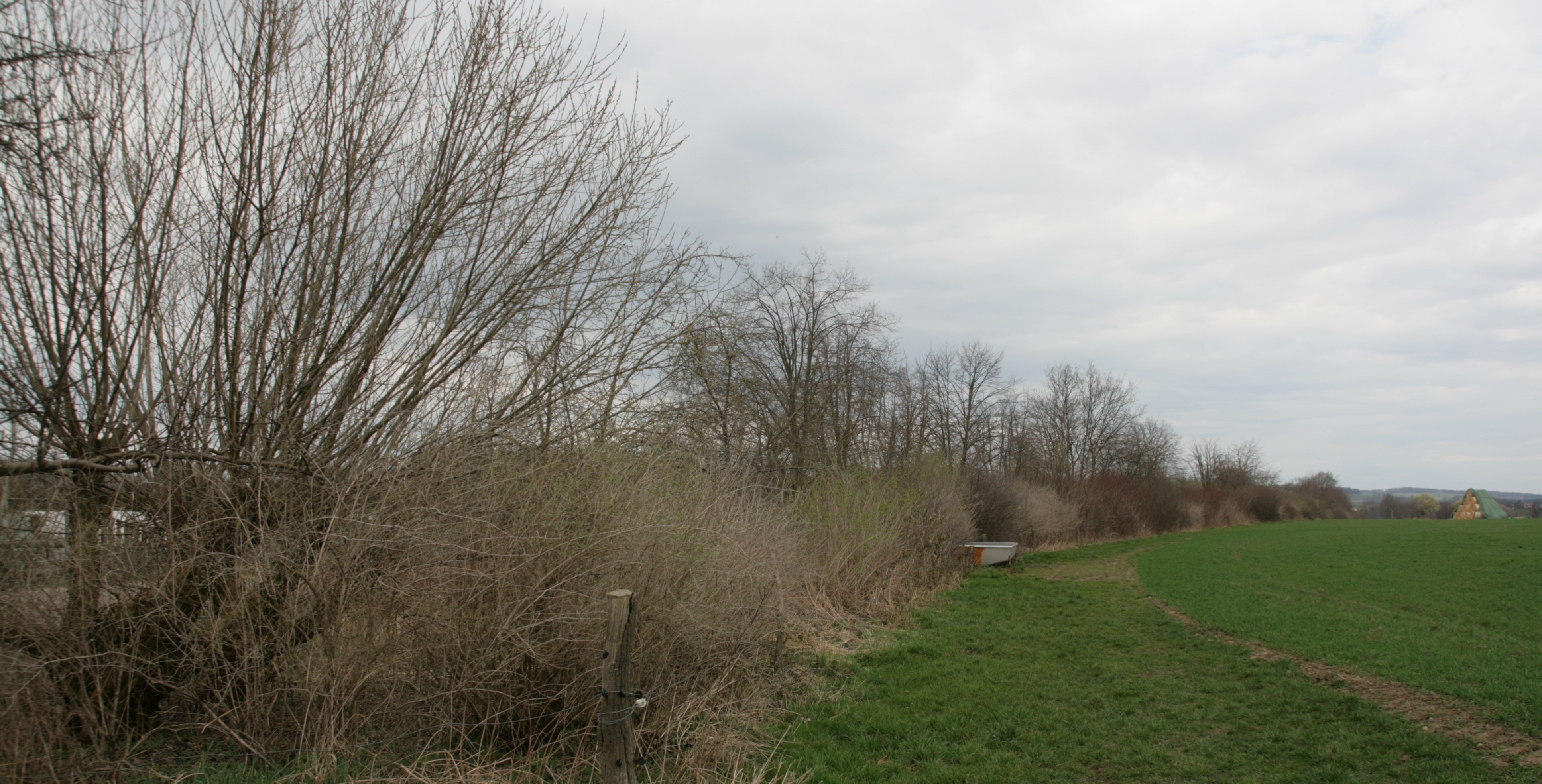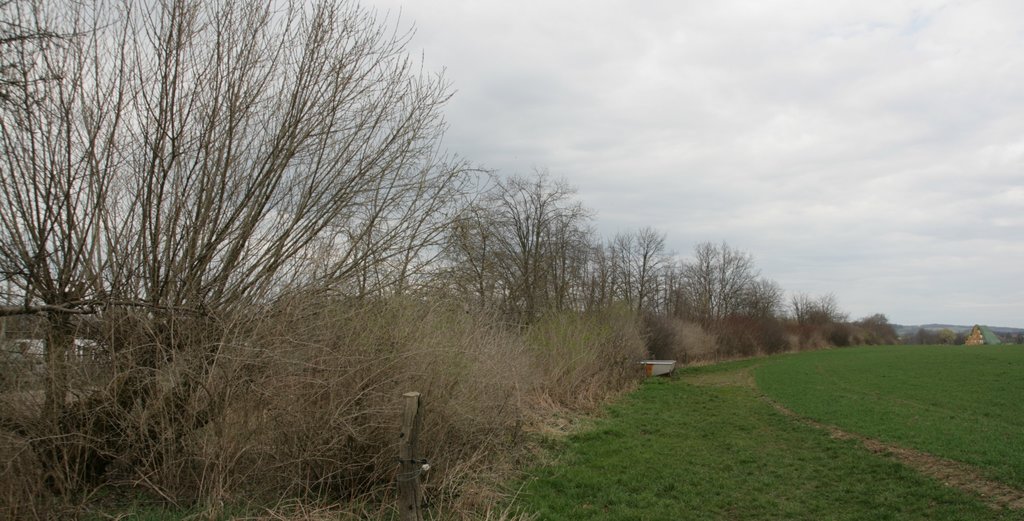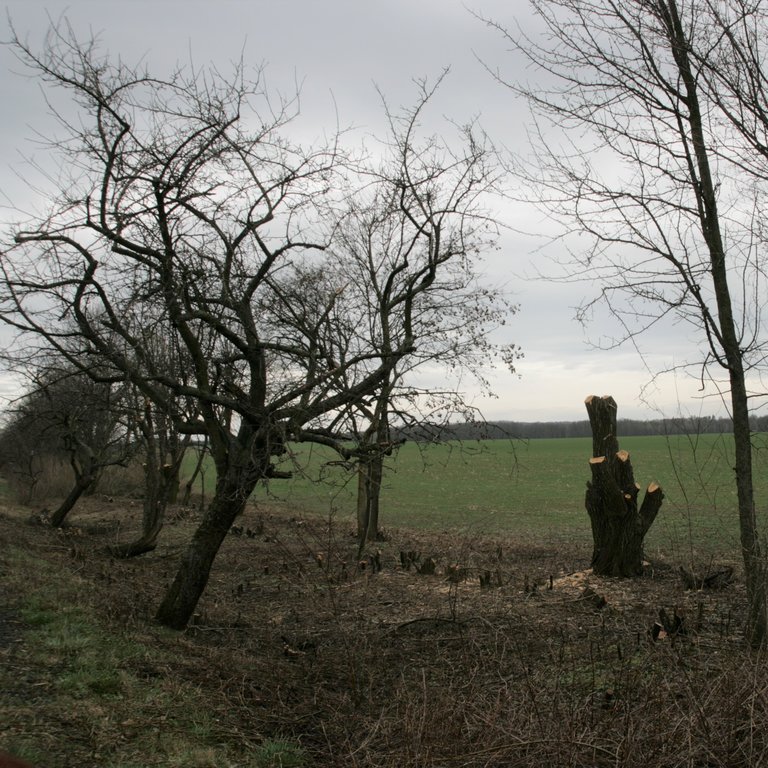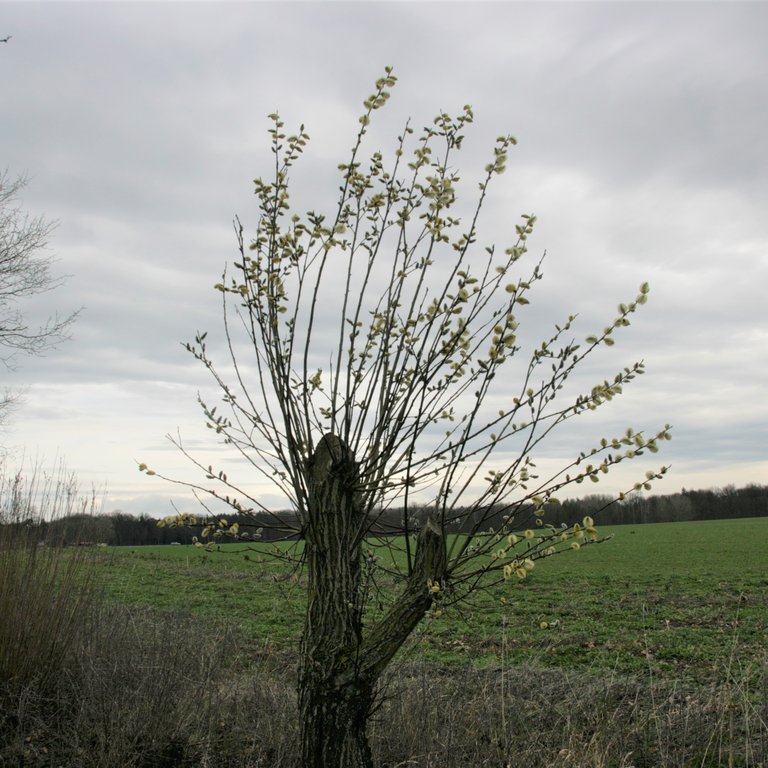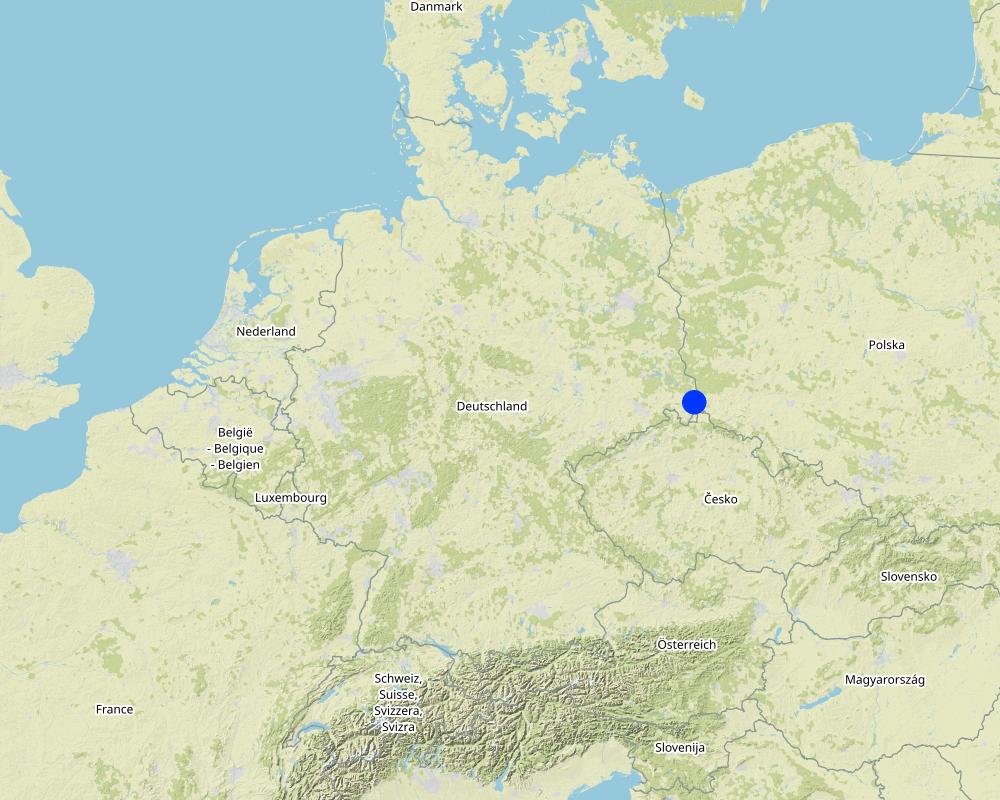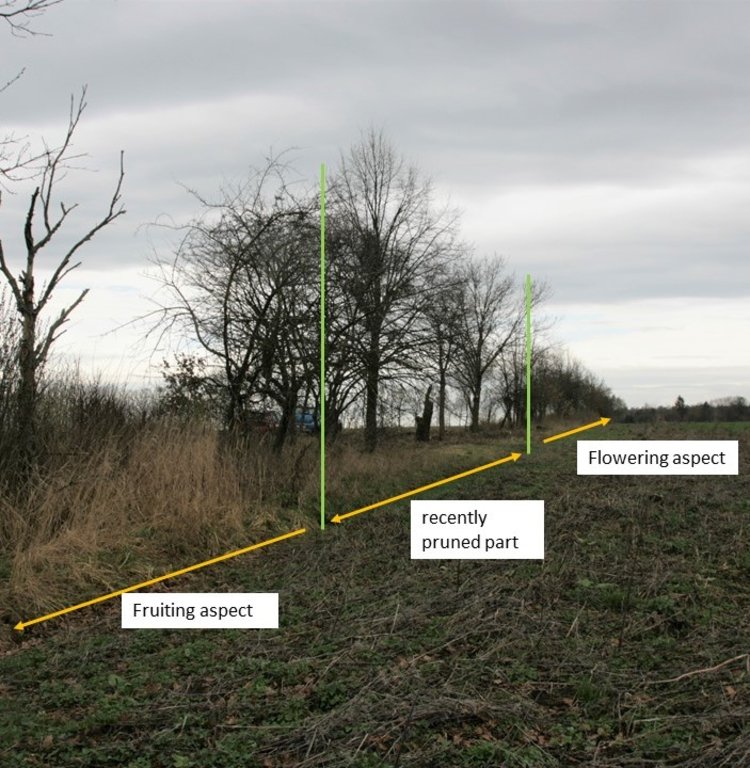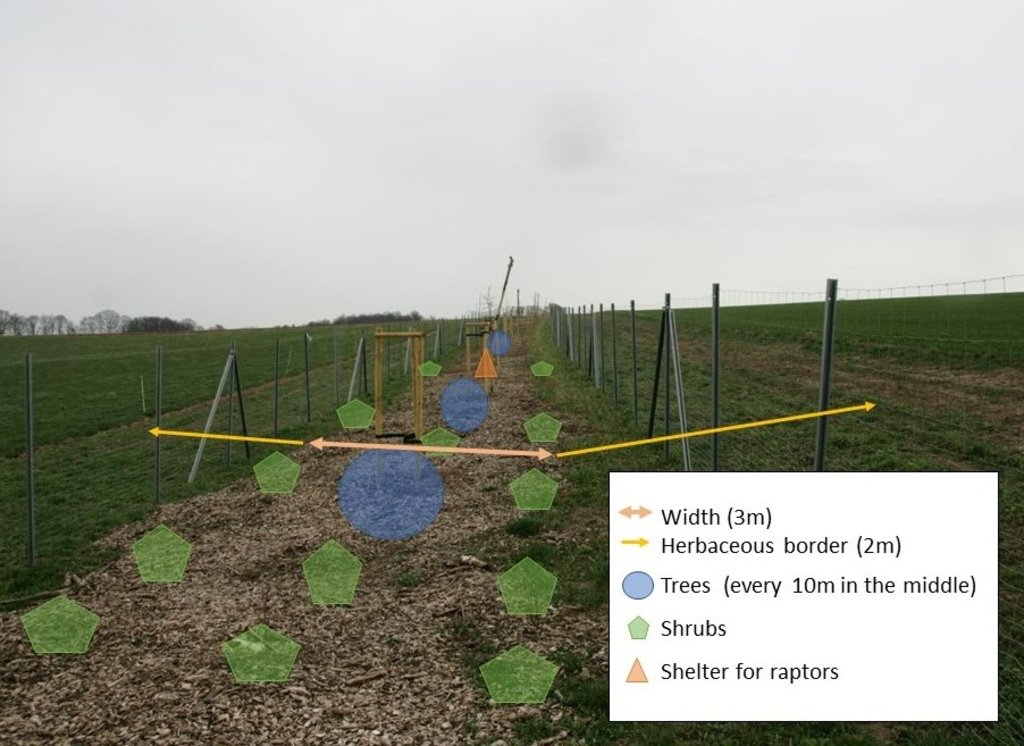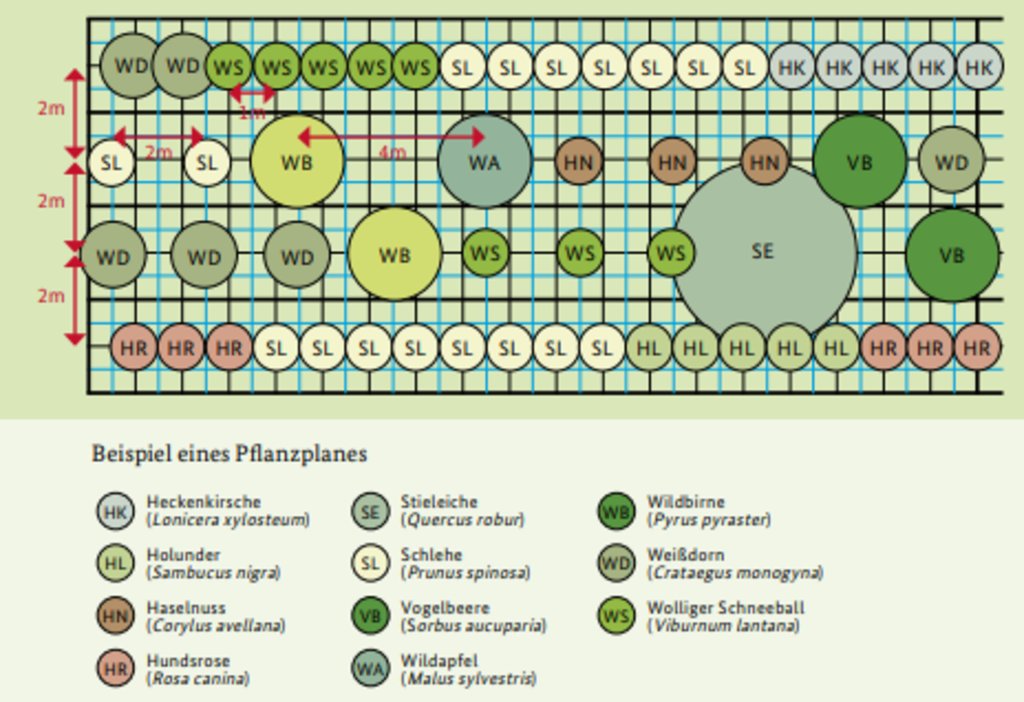Hedges to subdivide fields and provide environmental benefits [Germany]
- Creation:
- Update:
- Compiler: Felix Witing
- Editors: Michael Strauch, Mona Pauer
- Reviewers: William Critchley, Rima Mekdaschi Studer
Hecken und Baumreihen zur Unterteilung von Feldern
technologies_6266 - Germany
View sections
Expand all Collapse all1. General information
1.2 Contact details of resource persons and institutions involved in the assessment and documentation of the Technology
SLM specialist:
SLM specialist:
Name of project which facilitated the documentation/ evaluation of the Technology (if relevant)
OPtimal strategies to retAIN and re-use water and nutrients in small agricultural catchments across different soil-climatic regions in Europe (OPTAIN)Name of the institution(s) which facilitated the documentation/ evaluation of the Technology (if relevant)
Helmholtz Centre for Environmental Research (UFZ) - Germany1.3 Conditions regarding the use of data documented through WOCAT
The compiler and key resource person(s) accept the conditions regarding the use of data documented through WOCAT:
Yes
1.4 Declaration on sustainability of the described Technology
Is the Technology described here problematic with regard to land degradation, so that it cannot be declared a sustainable land management technology?
No
2. Description of the SLM Technology
2.1 Short description of the Technology
Definition of the Technology:
Hedges are structured shrub communities that subdivide fields, reduce soil erosion, and provide valuable semi-natural habitats.
2.2 Detailed description of the Technology
Description:
Hedges subdivide large fields and provide multiple other benefits. Improved soil structure, and deep and dense root systems in the hedgerow area result in slowing runoff from adjacent land, increasing infiltration rates and capturing sediment. These factors reduce water erosion and nutrient leaching. On steep slopes or embankments, deep roots can prevent wet soils from slipping. Additionally, hedges can acts as windbreaks and thus reduce wind erosion of light soils: simultaneously soil particles in the air are filtered out by hedges. Hedgerows provide a habitat for various wild animals for their food, reproduction, shelter and retreat. The hedge can act as a measure for natural pest control: for example as a habitat for raptors that control voles. A well-placed hedge may improve the microclimate of a field by reducing wind speed and increasing soil moisture in the wind-protected area.
An effective hedge must be strategically sited and carefully established. The optimal hedge is a multi-row hedgerow (at least three rows) with a herbaceous border on both sides. The width of the hedge should be, ideally, 5-6 m (LfULG, 2014). Hedges are best planted parallel to the contour line, along the direction of cultivation, not on the headland, and should be sited a minimum of 20 m from the nearest road. Preparing a planting plan is very important for the establishment of a hedge. It should be based on native species (Kühne et al., 2018). Planting is usually done from October to November. Since a newly planted hedge requires regular costly watering (100 litres for trees, 20 litres for shrubs) spring planting is not advisable.
Maintenance pruning can be divided into hard pruning (every 10-15 years) and pruning for shape and maintenance (every year). Hedges that are not maintained will lack fruit, develop deadwood, or simply die back. Maintenance pruning should be done in February or March when there is no frost and before the plants sprout. A clean, smooth cut is important to prevent fungi or diseases from entering the plants. Hard pruning of hedges means cutting shrubs to a height of a few centimetres. As a general rule, a hedge should be divided into at least three sections, which should be hard pruned in succession. In this way, the hedge always retains a flowering and a fruiting element. Individual trees should be left as shelter/seed trees. The annual maintenance cuts should be used to shape the hedge, but also to remove broken or diseased branches (NABU Niedersachsen).
Hedgerows also have drawbacks for farmers and landowners. They take up cropland, which initially reduces yields. Once established, they cannot be easily removed, limiting management flexibility. It is uncertain whether hedges will be eligible for financial support or whether they will remain eligible after several years. For example, a hedge in Germany that is initially eligible for financial support must prove, after 10 years, that all the required species are still part of the hedge. If not, the money received from the subsidy must be repaid. Moreover, maintenance requires a lot of work, which needs to be compensated by subsidies (Thünen, 2021).
2.3 Photos of the Technology
2.5 Country/ region/ locations where the Technology has been applied and which are covered by this assessment
Country:
Germany
Region/ State/ Province:
Saxony
Further specification of location:
Pfaffendorf
Specify the spread of the Technology:
- applied at specific points/ concentrated on a small area
Is/are the technology site(s) located in a permanently protected area?
No
Map
×2.6 Date of implementation
Indicate year of implementation:
2003
2.7 Introduction of the Technology
Specify how the Technology was introduced:
- through land users' innovation
Comments (type of project, etc.):
It was the land users’ own decision to implement that hedge. They are doing organic farming and wanted some natural shelter against the pesticide drift from the neighbouring – conventionally managed - fields (this was the main reason, beside other environmental benefits of hedges the land users were aware of).
3. Classification of the SLM Technology
3.1 Main purpose(s) of the Technology
- improve production
- reduce, prevent, restore land degradation
- conserve ecosystem
- preserve/ improve biodiversity
- adapt to climate change/ extremes and its impacts
3.2 Current land use type(s) where the Technology is applied
Land use mixed within the same land unit:
Yes
Specify mixed land use (crops/ grazing/ trees):
- Agroforestry

Cropland
- Annual cropping
Annual cropping - Specify crops:
- vegetables - root vegetables (carrots, onions, beet, other)
Number of growing seasons per year:
- 1
Is intercropping practiced?
No
Is crop rotation practiced?
Yes
If yes, specify:
we have no information about this

Forest/ woodlands
- Hedge/ tree row on the field
- rosa villosa (Apfelrose), salix caprea (Salweide)
Are the trees specified above deciduous or evergreen?
- deciduous
Products and services:
- Fruits and nuts
- Nature conservation/ protection
3.3 Has land use changed due to the implementation of the Technology?
Has land use changed due to the implementation of the Technology?
- No (Continue with question 3.4)
3.4 Water supply
Water supply for the land on which the Technology is applied:
- rainfed
Comments:
Newly planted hedges require regular watering (100 litres for trees, 20 litres for shrubs).
3.5 SLM group to which the Technology belongs
- windbreak/ shelterbelt
- cross-slope measure
- integrated pest and disease management (incl. organic agriculture)
3.6 SLM measures comprising the Technology

vegetative measures
- V1: Tree and shrub cover
3.7 Main types of land degradation addressed by the Technology

soil erosion by water
- Wt: loss of topsoil/ surface erosion
- Wo: offsite degradation effects

soil erosion by wind
- Et: loss of topsoil
- Ed: deflation and deposition

chemical soil deterioration
- Cp: soil pollution

physical soil deterioration
- Pc: compaction
- Pk: slaking and crusting
- Pi: soil sealing

biological degradation
- Bc: reduction of vegetation cover
- Bh: loss of habitats
- Bq: quantity/ biomass decline
- Bs: quality and species composition/ diversity decline
- Bl: loss of soil life
- Bp: increase of pests/ diseases, loss of predators

water degradation
- Hs: change in quantity of surface water
- Hp: decline of surface water quality
Comments:
Physical soil degradation refers to the area below the hedge and next to the hedge (3-4 m), but not around it, e.g. in the field. Other types of degradation do refer to the area around the hedge.
3.8 Prevention, reduction, or restoration of land degradation
Specify the goal of the Technology with regard to land degradation:
- prevent land degradation
- reduce land degradation
4. Technical specifications, implementation activities, inputs, and costs
4.1 Technical drawing of the Technology
Technical specifications (related to technical drawing):
From a conservation point of view, a well-maintained hedge should always have a flowering aspect (the right part of the hedge in the picture) and a fruiting aspect (the left part of the hedge). After pruning, there is neither a flowering aspect nor a fruiting aspect, so the hedge is divided into at least three maintenance sections with different times for pruning.
Author:
Mona Pauer
Date:
23/03/2023
Technical specifications (related to technical drawing):
A hedge should have at least three rows of taller woody plants (trees) every 10 m in the center to low woody plants (shrubs) at the edges. A herbaceous border on both sides is ideal. The width of the strip should be between 5 and 9 meters. An important guide before planting is a planting plan (an example is given in the online version of this documentation).
Author:
Mona Pauer (based on a example of a planting plan in Kühne et al. 2018, p.73)
Date:
23/03/2023
Technical specifications (related to technical drawing):
Example of a planting plan for a three-row-hedge
Author:
Kühne et al. 2018, p. 73
4.2 General information regarding the calculation of inputs and costs
Specify how costs and inputs were calculated:
- per Technology area
Indicate size and area unit:
1 m²
other/ national currency (specify):
€
If relevant, indicate exchange rate from USD to local currency (e.g. 1 USD = 79.9 Brazilian Real): 1 USD =:
0.91
Indicate average wage cost of hired labour per day:
18.70€ per hour
4.3 Establishment activities
| Activity | Timing (season) | |
|---|---|---|
| 1. | Planning / preparing a planting plan | anytime but before planting |
| 2. | Preparing area (preparation of the soil, e.g. ploughing) | late summer- atumn |
| 3. | Planting | late summer- autumn |
| 4. | Protection measures for newly planted hedge (application of a protective coating, construction of protective fence) | after planting |
| 5. | Maintenance measures for newly planted hedge | especially the first year after planting |
| 6. | Optional: preparing area of herbarcious border (preparation of soil) | late summer- atumn |
| 7. | Optional: sawing of herbacious border | late summer- atumn |
| 8. | Optional: rolling of herbacious border | late summer- atumn |
4.4 Costs and inputs needed for establishment
If you are unable to break down the costs in the table above, give an estimation of the total costs of establishing the Technology:
25.0
If land user bore less than 100% of costs, indicate who covered the remaining costs:
7.54 €/m² are covered by the state of Saxony, RL Ne/ 2014- Planting hedges, copses and riparian woods (SMUL Sachsen a)
Comments:
The implementation costs of a hedge include the plants (trees, shrubs, grass seed) and required materials (e.g. fencing, perches for birds of prey, anti-mole mesh, trunk protection, bark mulch) and the rental of required machinery.
4.5 Maintenance/ recurrent activities
| Activity | Timing/ frequency | |
|---|---|---|
| 1. | Cuts to put hedges on stock | every 5-10 years |
| 2. | Shape and maintenance cuts | every year |
Comments:
In our documentation, the landscape maintenance association will check the hedge every five years to see how much it has grown back and whether or not it can be put back on the stock.
4.6 Costs and inputs needed for maintenance/ recurrent activities (per year)
If you are unable to break down the costs in the table above, give an estimation of the total costs of maintaining the Technology:
11.73
If land user bore less than 100% of costs, indicate who covered the remaining costs:
3.91 €/m² are covered by the state of Saxony, RL Ne/ 2014- Woody plant rehabilitation - Hard pruning (SMUL Sachsen b)
Comments:
Costs only include maintenance activity 'hard pruning' over a five year period.
4.7 Most important factors affecting the costs
Describe the most determinate factors affecting the costs:
The implementation costs of a hedge are rather high and include the plants (trees, shrubs, grass seed), required materials (e.g. fencing, perches for birds of prey, anti-mole mesh, trunk protection, bark mulch), the rental of required machinery and irrigation.
5. Natural and human environment
5.1 Climate
Annual rainfall
- < 250 mm
- 251-500 mm
- 501-750 mm
- 751-1,000 mm
- 1,001-1,500 mm
- 1,501-2,000 mm
- 2,001-3,000 mm
- 3,001-4,000 mm
- > 4,000 mm
Specify average annual rainfall (if known), in mm:
745.00
Indicate the name of the reference meteorological station considered:
https://whh-kliwes.de/mapview
Agro-climatic zone
- sub-humid
Length of growing period (LGP): 209 days (https://www.umwelt.sachsen.de/dauer-der-vegetationsperiode-30631.html)
5.2 Topography
Slopes on average:
- flat (0-2%)
- gentle (3-5%)
- moderate (6-10%)
- rolling (11-15%)
- hilly (16-30%)
- steep (31-60%)
- very steep (>60%)
Landforms:
- plateau/plains
- ridges
- mountain slopes
- hill slopes
- footslopes
- valley floors
Altitudinal zone:
- 0-100 m a.s.l.
- 101-500 m a.s.l.
- 501-1,000 m a.s.l.
- 1,001-1,500 m a.s.l.
- 1,501-2,000 m a.s.l.
- 2,001-2,500 m a.s.l.
- 2,501-3,000 m a.s.l.
- 3,001-4,000 m a.s.l.
- > 4,000 m a.s.l.
Indicate if the Technology is specifically applied in:
- not relevant
5.3 Soils
Soil depth on average:
- very shallow (0-20 cm)
- shallow (21-50 cm)
- moderately deep (51-80 cm)
- deep (81-120 cm)
- very deep (> 120 cm)
Soil texture (topsoil):
- medium (loamy, silty)
Soil texture (> 20 cm below surface):
- medium (loamy, silty)
Topsoil organic matter:
- medium (1-3%)
If available, attach full soil description or specify the available information, e.g. soil type, soil PH/ acidity, Cation Exchange Capacity, nitrogen, salinity etc.
Luvisol (Pseudogley Parabraunerde)
5.4 Water availability and quality
Ground water table:
< 5 m
Availability of surface water:
medium
Water quality (untreated):
poor drinking water (treatment required)
Water quality refers to:
surface water
Is water salinity a problem?
No
Is flooding of the area occurring?
No
5.5 Biodiversity
Species diversity:
- high
Habitat diversity:
- high
Comments and further specifications on biodiversity:
High diversity only because of the hedgerow. Without, it would be low to medium.
5.6 Characteristics of land users applying the Technology
Sedentary or nomadic:
- Sedentary
Market orientation of production system:
- commercial/ market
Off-farm income:
- less than 10% of all income
Relative level of wealth:
- poor
- average
Individuals or groups:
- groups/ community
Level of mechanization:
- mechanized/ motorized
Gender:
- women
- men
Age of land users:
- middle-aged
Indicate other relevant characteristics of the land users:
Organic farm community (demeter quality)
5.7 Average area of land used by land users applying the Technology
- < 0.5 ha
- 0.5-1 ha
- 1-2 ha
- 2-5 ha
- 5-15 ha
- 15-50 ha
- 50-100 ha
- 100-500 ha
- 500-1,000 ha
- 1,000-10,000 ha
- > 10,000 ha
Comments:
not known
5.8 Land ownership, land use rights, and water use rights
Land ownership:
- individual, not titled
Land use rights:
- leased
- individual
Water use rights:
- communal (organized)
Are land use rights based on a traditional legal system?
No
5.9 Access to services and infrastructure
health:
- poor
- moderate
- good
education:
- poor
- moderate
- good
technical assistance:
- poor
- moderate
- good
employment (e.g. off-farm):
- poor
- moderate
- good
markets:
- poor
- moderate
- good
energy:
- poor
- moderate
- good
roads and transport:
- poor
- moderate
- good
drinking water and sanitation:
- poor
- moderate
- good
financial services:
- poor
- moderate
- good
6. Impacts and concluding statements
6.1 On-site impacts the Technology has shown
Socio-economic impacts
Production
crop production
crop quality
Comments/ specify:
Less input of pesticides from conventional agriculture.
risk of production failure
Comments/ specify:
In direct surrounding of the hedge.
production area
Income and costs
expenses on agricultural inputs
farm income
diversity of income sources
Comments/ specify:
Possible to sell berries and fruits from the hedge.
workload
Ecological impacts
Water cycle/ runoff
surface runoff
Soil
soil moisture
Comments/ specify:
In direct surrounding of the hedge.
soil cover
Comments/ specify:
Considering the area of hedge.
soil loss
soil accumulation
soil compaction
Comments/ specify:
In direct surrounding of the hedge.
soil organic matter/ below ground C
Comments/ specify:
In direct surrounding of the hedge.
Biodiversity: vegetation, animals
Vegetation cover
plant diversity
invasive alien species
Comments/ specify:
It is important to use local planting/maintenance materials, e.g. regarding wood chips.
animal diversity
beneficial species
habitat diversity
pest/ disease control
Climate and disaster risk reduction
drought impacts
Comments/ specify:
In direct surrounding of the hedge.
wind velocity
micro-climate
Specify assessment of on-site impacts (measurements):
Estimates based on land users' perception (not based on measurements).
6.2 Off-site impacts the Technology has shown
water availability
Comments/ specify:
Impact decreases with distance from the hedge.
groundwater/ river pollution
buffering/ filtering capacity
Comments/ specify:
Impact decreases with distance from the hedge.
wind transported sediments
damage on neighbours' fields
impact of greenhouse gases
Comments/ specify:
Impact decreases with distance from the hedge.
Specify assessment of off-site impacts (measurements):
Estimates based on land users' perception (not based on measurements).
6.3 Exposure and sensitivity of the Technology to gradual climate change and climate-related extremes/ disasters (as perceived by land users)
Gradual climate change
Gradual climate change
| Season | increase or decrease | How does the Technology cope with it? | |
|---|---|---|---|
| seasonal temperature | spring | increase | not well |
| other gradual climate change | heavy rain events | increase | well |
6.4 Cost-benefit analysis
How do the benefits compare with the establishment costs (from land users’ perspective)?
Short-term returns:
negative
Long-term returns:
slightly positive
How do the benefits compare with the maintenance/ recurrent costs (from land users' perspective)?
Short-term returns:
slightly negative
Long-term returns:
positive
Comments:
This is a reasonable estimate from the SLM specialist's perspective, but not from the land user's perspective.
6.5 Adoption of the Technology
- single cases/ experimental
6.6 Adaptation
Has the Technology been modified recently to adapt to changing conditions?
Yes
If yes, indicate to which changing conditions it was adapted:
- climatic change/ extremes
Specify adaptation of the Technology (design, material/ species, etc.):
no planting in spring
6.7 Strengths/ advantages/ opportunities of the Technology
| Strengths/ advantages/ opportunities in the land user’s view |
|---|
| The hedge as a habitat acts as a natural plant protection measure, e.g. the hedge as a habitat for raptors can be a pest control measure against voles. |
| Protection against drift from conventional crop protection products. |
| Strengths/ advantages/ opportunities in the compiler’s or other key resource person’s view |
|---|
| Promoting biodiversity (habitats for bees, birds and amphibians) |
| Reducing soil erosion (wind and water) |
| Improve micro-climate (may increase yield) |
| On steep slopes or embankments, deep roots prevent wet soils from slipping. |
6.8 Weaknesses/ disadvantages/ risks of the Technology and ways of overcoming them
| Weaknesses/ disadvantages/ risks in the land user’s view | How can they be overcome? |
|---|---|
| Consume cropland, which initially leads to a reduces yields. | A better compensation by subsidies is required. |
| Weaknesses/ disadvantages/ risks in the compiler’s or other key resource person’s view | How can they be overcome? |
|---|---|
| Once established, hedgerows cannot be easily removed, which limits management flexibility. | Farmers should consider management and practicality when planning the hedge. |
| Insufficient market opportunities for shrub cuttings. | Farmers could use shrub cuttings to mulch the hedge or eventually for replanting trees / further hedges. |
| Maintenance includes a lot of labor. | These efforts should therefore be compensated by subsidies. |
| Increased machinery operation costs and fuel use (so greater carbon dioxide emissions) because of more turning and shorter machine runs. | Farmers should consider this when planning the hedge, e.g. fields should not be cut into too small parts which are impractical or too expensive to be managed. |
7. References and links
7.1 Methods/ sources of information
- field visits, field surveys
3
- interviews with SLM specialists/ experts
2
- compilation from reports and other existing documentation
When were the data compiled (in the field)?
23/03/2023
7.2 References to available publications
Title, author, year, ISBN:
Kühne et al. 2018: Hecken und Raine in der Agrarlandschaft- Bedeutung, Neuanlage, Pflege
Available from where? Costs?
ble-medienservice.de, download: https://www.ble-medienservice.de/1619-1-hecken-und-raine-in-der-agrarlandschaft.html , free
Title, author, year, ISBN:
Weber, E. 2003: Gebüsche, Hecken, Krautsäume
Available from where? Costs?
ulmer.de
7.3 Links to relevant online information
Title/ description:
SMUL Sachsen 2021a: Anlage von Hecken, Feldgehölzen und Ufergehölzen (RL NE/2014)
URL:
https://www.smul.sachsen.de/foerderung/download/MB_Anlage_Hecken_Feld_Ufergehoelze_01.11.2021.pdf
Title/ description:
NABU Niedersachsen: Hecken pflegen - so geht's
URL:
https://niedersachsen.nabu.de/tiere-und-pflanzen/pflanzen/hecken/04719.html
Title/ description:
Thünen 2021: Hecken sind Klimaschützer
URL:
https://www.thuenen.de/de/fachinstitute/laendliche-raeume/lebensverhaeltnisse-in-laendlichen-raeumen/aktuelles-und-service/pressemitteilungen/detail-1-5/hecken-sind-klimaschuetzer
Title/ description:
Wasserhaushaltsportal Sachsen: KLiWES 2.1 IST-Zustand 1988-2015
URL:
https://whh-kliwes.de/mapview
Title/ description:
SMUL Sachsen 2021b: Gehölzsanierung Hecken, Feld- und Ufergehölze (RL NE/2014)
URL:
https://www.smekul.sachsen.de/foerderung/download/MB_Gehoelzsanierung_Hecken_01052022.pdf
Links and modules
Expand all Collapse allLinks
No links
Modules
No modules


